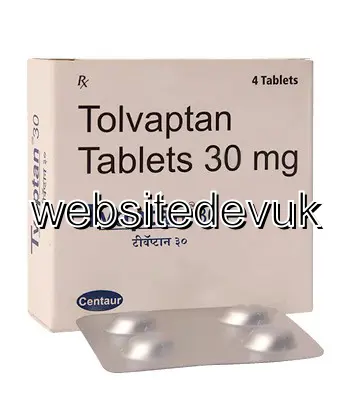| Package | Dosage | Price | Price per Dose | |
|---|---|---|---|---|
| Dosage: 15mg | ||||
| 180 pill | 15mg | £1,037.50 | £5.76 | |
| 120 pill | 15mg | £703.39 | £5.86 | |
| 90 pill | 15mg | £536.33 | £5.96 | |
| 60 pill | 15mg | £363.41 | £6.06 | |
| 30 pill | 15mg | £184.63 | £6.15 | |
| 20 pill | 15mg | £125.04 | £6.25 | |
| 10 pill | 15mg | £63.49 | £6.35 | |
| Dosage: 30mg | ||||
| 120 pill | 30mg | £916.36 | £7.64 | |
| 90 pill | 30mg | £699.48 | £7.78 | |
| 60 pill | 30mg | £474.78 | £7.91 | |
| 30 pill | 30mg | £239.34 | £7.98 | |
| 20 pill | 30mg | £161.19 | £8.06 | |
| 10 pill | 30mg | £81.08 | £8.11 | |

Tolvaptan Description
Overview of Tolvaptan
Tolvaptan is a prescription medication primarily used to treat certain medical conditions involving fluid retention. It belongs to a class of drugs known as vasopressin receptor antagonists. This medication is designed to help the body get rid of excess water by blocking the action of vasopressin, a hormone that promotes water retention in the kidneys. By doing so, Tolvaptan helps to restore the balance of fluids in the body and alleviates symptoms caused by fluid overload.
Uses and Indications
The main uses of Tolvaptan include the treatment of hyponatremia, which is a condition characterized by low sodium levels in the blood. It is often associated with syndromes such as syndrome of inappropriate antidiuretic hormone secretion (SIADH) and certain types of heart failure. Additionally, Tolvaptan is approved for managing autosomal dominant polycystic kidney disease (ADPKD). In this chronic condition, the drug helps slow down the growth of kidney cysts, thereby preserving kidney function over time. It is important to use Tolvaptan under strict medical supervision for these specific indications.
How It Works
Tolvaptan works by selectively blocking vasopressin V2 receptors in the kidneys. Vasopressin is a hormone that signals the kidneys to reabsorb water. When Tolvaptan antagonizes these receptors, it prevents vasopressin from exerting its effects, leading to increased free water excretion. This process, known as aquaresis, results in a reduction of water retention without significant loss of electrolytes like sodium or potassium. This mechanism makes Tolvaptan especially effective in correcting hyponatremia caused by underlying causes like SIADH.
Dosage and Administration
The dosage of Tolvaptan varies based on the condition being treated and the patient's response. It is typically started at a low dose to monitor effects and prevent rapid shifts in sodium levels. For hyponatremia, the initial dose may range from 15 to 30 mg daily, with adjustments made based on blood sodium levels and clinical response. In the case of ADPKD, higher doses may be utilized, but always under strict medical guidance. It is crucial to follow the prescribed dosage and attend regular check-ups to monitor electrolytes and kidney function during therapy.
Possible Side Effects
While Tolvaptan is generally well tolerated, it can cause side effects in some individuals. Common adverse effects include thirst, dry mouth, increased urination, and dehydration. Because the medication influences fluid balance, there is a risk of developing rapid changes in sodium levels, which can lead to serious complications if not managed properly. More severe but less common side effects include liver damage, which necessitates regular liver function tests during treatment. Patients should report any symptoms such as jaundice, severe abdominal pain, or allergic reactions promptly.
Precautions and Warnings
Tolvaptan requires careful monitoring, especially of blood sodium levels, during therapy. It should be used with caution in patients with liver problems, as liver toxicity has been reported. The medication is not suitable for all patients, particularly those with hypovolemic hyponatremia, kidney failure, or certain heart conditions. Pregnant women should discuss potential risks with their healthcare provider, as safety during pregnancy has not been fully established. Additionally, abrupt discontinuation of Tolvaptan can lead to fluid imbalance, so any changes in therapy should be done under medical supervision.
Conclusion
Tolvaptan offers an effective option for managing specific fluid-related conditions, especially hyponatremia and polycystic kidney disease. Its targeted action on vasopressin receptors allows for precise control over fluid excretion. However, like all medications, it requires careful dosing, regular monitoring, and consultation with healthcare professionals to ensure safe and effective treatment. Patients should be aware of potential side effects and adhere strictly to medical advice during therapy to maximize benefits and minimize risks.
